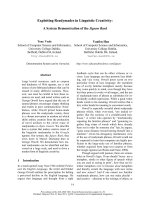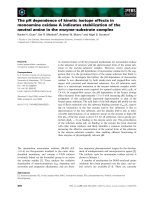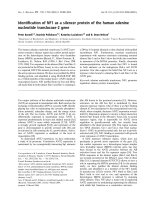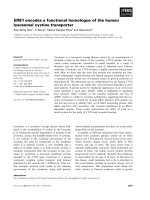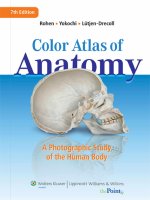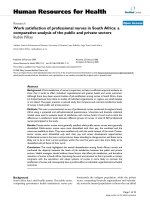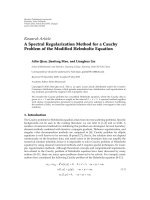solving-heterogeneities-in-defibrillation-for-a-vascular-remodel-of-the-human-heart-jcrc-18
Bạn đang xem bản rút gọn của tài liệu. Xem và tải ngay bản đầy đủ của tài liệu tại đây (1.31 MB, 3 trang )
ISSN: 2573-9565
Research Article
Journal of Clinical Review & Case Reports
Solving Heterogeneities in Defibrillation for a Vascular Remodel of the Human
Heart
Arianna Pahlavan
Simons Summer Research Program, Stony Brook University,
New York, United States of America
*
Corresponding author
Arianna Pahlavan, Simons Summer Research Program, Stony Brook
University, Jericho High School Science Research, Jericho, New York, United
States of America E-mail:
Submitted: 24 Oct 2018; Accepted: 31 Oct 2018; Published: 15 Nov 2018
Abstract
Introduction: Current mathematical models impede the amelioration of defibrillation protocol. Heterogeneities such as intracellular
clefts, scarring, blood vessels, and fiber orientation are excluded in modeling. Such geometries pose a positive curvature, magnifying
resistance when faced with electrical shock. Thus, such geometries have the potential of revolutionizing AED machines-a prospect
we have not gained enough data on to consider.
Objective: The purpose of my study is to quantify the effect of each non-conformity in relation to the electrical dynamics of the
human heart. Post-quantification, I hypothesize that the electrical impedance decreases as the heterogeneity size decreases. Posed
with such a window of pertinence, my goal is to remodel the human heart including all heterogeneities-a previous infeasibility.
Methodology: Using CHASTE cardiac software library, electrical shock was applied to cardiac tissue engineered in Mesh Lab.
Cardiac tissue, the slab geometries, contained blood vessels in the center of varying vessel size-400, 200, 100μm.
Results: Overall, the results showed that without heterogeneities biological reality and computational modeling have severe
discrepancies; mainly, the experimentally supported therapy of low-energy ant fibrillation shows failure in math modeling.
Perpendicular fiber orientation perceived shock at a 1.74x more efficacies. In the most sensitive case scenario, 400 and 200μm
affected the defibrillating wave-front, while the 100μm heterogeneity did not.
Conclusion: All heterogeneities cannot be extracted by magnetic resonance angiography due to its limiting factor of magnetic
susceptibility; however, by filtering can anatomically accurate mathematical remodel capable of representing the necessary cardiac
vessels is created.
Keywords: Leap, Defibrillation, Minimum Radius, Model
Filtration, Computational Model, Mathematical Modeling, Chaste
Cardiac
Introduction
Cardiovascular disease is the No.1 killer worldwide [1]. The most
common type, electrical, ends in a sudden cardiac arrhythmia. Current
anti-arrhythmia treatments are ineffective-a 3000V shock scars the
surrounding cardiac tissue, which causes successive arrhythmias in
the future [2]. Current defibrillation therapy permanently damages
the heart, and the cure-pacemakers-are also problematic: installing
a separate system to synchronize with the complexity of the human
heart, pacemakers fail an impulse is sent too soon or too quick [3].
Mathematical modeling will ameliorate treatments, but current math
models are inadequate [4]. In computational research, mediums
that can be mathematized holistically are called homogeneities
(such as, muscle interaction), while a realm of heterogeneities that
cannot be mathematized also exist (such as, intracellular clefts,
fiber orientation, blood vessels, and scarring) [5]. Heterogeneities
J Clin Rev Case Rep, 2018
are excluded because the human heart has a fractal configuration of
such geometries, and its inclusion rests on the ability of magnetic
resonance angiography. Smaller heterogeneities cannot be extracted
due to their low magnetic susceptibility [6].
Figure 1: MRA extraction of cardiac geometries.
Methodology
Muscle tissue was constructed in Mesh Lab. The voltage shock
formula was used as a pre-requisite to calibrate the new code. All files
were created, edited, and recompiled on a personal Linux system.
Simulations were sent to Stony Brook’s LiRED machines where
96 processors were used for 10 hours. Code was written mainly in
CHASTE cardiac altered by adding New Restart functionality and
using python scripts to fill in the missing notations in CHASTE
cardiac such as tanθ. The bidomain method explicates the trans
Volume 3 | Issue 8 | 1 of 3
membrane potential of the heart. The ionic source term, I’() ϕ, y,
was resolved by the ionic current method. The operating splitting
method solved the bidomain equations.
As shock strength increased, the disparity between the perpendicular
and parallel difference exasperated.
Figure 6: Excitation disparity between parallel and perpendicular.
Figure 2: Flow chart of methods.
Creating a ratio between the Trans membrane potential of
perpendicular and parallel shock, the relationship is defined as: By
solving the infinite geometric series, perpendicular fiber orientation
will perceive shock at a 1.74 times more efficacy than parallel
shock. Since its more sensitive, heterogeneities that don’t effect
perpendicular defibrillation, wouldn’t affect parallel anti-fibrillationthis is the most optimized case scenario.
Results and Discussion
The widely-used Mahajan 2008 cardiac model, which does not
include heterogeneities, was tested against a .33V shock. Virtual
electrodes (VE) were not formed by the 1st shock, nor by the 2nd,
3rd, 4th, or 5th. Depolarization, VEs, was supposed to occur.
Figure 7: 1.74 ratios
(1)
Figure 3: MRA extraction of cardiac geometries
To solve for the discrepancy, the anatomic model (Figure 1) needed
to be filtered using a minimum radius. To find a minimum radius, the
most optimized case scenario defined by when shock is perceived
most efficaciously needed to be defined.
Parallel fiber orientation didn’t produce enough electrical resistance
against the incoming shock for the blood vessel to locally react.
(2)
When a 6V shock was applied to a perpendicularly fiber slab
geometry against a 400μm heterogeneity, both VE formation and
velocity of moving wave-front were altered. Before the shock
even reached the heterogeneity, there was a local activation and
responding wave.
Figure 4: Change of voltage when shock is applied parallel
However, the perpendicular fiber orientation had localized virtual
electrode formation.
Figure 8: Effect of 400μm heterogeneity
Moving down to 200μm radius size heterogeneities, the tissue locally
activates and a returning wave is sent back to the site of shock
application at a negligible velocity. The effect is minimizing, but
still present.
Figure 5: Depolarization as shock is applied bidirectional to fibers
J Clin Rev Case Rep, 2018
Volume 3 | Issue 8 | 2 of 3
References
Figure 8: Effect of 200μm heterogeneity
Figure 8: Effect of 100μm heterogeneity
Since ≤ 100μm plays no role in cardiac defibrillation, all ≥ 100μm
radii heterogeneities were filtered to create the first anatomically
accurate mathematical remodel of the human heart.
Figure 9: New vascular remodel of the human heart
Conclusions
Previously, including the vascular configuration of the human heart
or any cardiac models was not feasible [7]. My novel approach of
quantifying the effect of non-continuous mediums revolutionizes
the capabilities of mathematical modeling as it can now go beyond
continuous biological realities. Since heterogeneities disrupt
the depolarization of charge, an inclusion for studying cardiac
defibrillation, would allow us to lower the voltage of treatment.
Given the low energy anti-fibrillation method, AED machines could
be reduced to .33V, a 1000-fold reduction [8]. Such a reduction
would make a costly solution to heart attack cost that of an allergic
reaction, saving the United States trillions of dollars in health care
[9]. However, world-wide, AED machines are inconvenient: too
much of a liability for the workplace, too powerful for the home
setting, and too expensive ($2k) for developing nations [10]. The
secondary alternative is to call for help, delaying CPR protocol
and each minute loss decreases chance of survival by 70% [11].
Futuristically, the relationship between blood vessels and SPH
intensity can be delineated for the elucidation of a minimum radius
in head-impact injury research [12]. Here, mathematical models
don’t include the complexity of vascular configuration [13] while
it’s known a high-density of anatomical structure will cushion the
brain during impact [14, 15].
J Clin Rev Case Rep, 2018
1. Benjamin EJ, Blaha MJ, Chiuve SE, Cushman M, Das SR, et
al. (2017) Heart Disease and Stroke Statistics-2017 Update:
A Report From the American Heart Association. Circulation
135: e146-e603.
2. David Farwell, Gollob MH (2007) Electrical heart disease:
Genetic and molecular basis of cardiac arrhythmias in normal
structural hearts. Can J Cardiol 23: 16A-22A.
3. Yorkey TJ, Webster JG, Tompkins WJ (1987) Comparing
reconstruction algorithms for electrical impedance tomography.
IEEE Trans Biomed Eng 34: 843-852.
4. Kern R, Sastrawan R, Ferber J, Stangl R, Luther J (2002)
Modeling and interpretation of electrical impedance spectra
of dye solar cells operated under open-circuit conditions.
Electrochemica Acta 47: 4213-4225.
5. Fish RM, Geddes LA (2009) Conduction of Electrical Current
to and Through the Human Body: A Review. Eplasty 9: e44.
6. Blad B, Johannesson J, Johnsson G, Bachman B, Lindstrom
K, et al. (1994) Waveform generator for electrical impedance
tomography (EIT) using linear interpolation with multiplying
D/A converters. J Med Eng Technol 18: 173-178.
7. Kwon O, Woo EJ, Yoon JR, Seo JK (2002) Magnetic resonance
electrical impedance tomography (MREIT): simulation study of
J-substitution algorithm. IEEE Trans Biomed Eng 49: 160-167.
8. Borcea L (2002) Electrical impedance tomography. Inverse
Problems 18.
9. Plonsey R (1982) the nature of sources of bioelectric and bio
magnetic fields. Biophysical Journal 39: 309-312.
10. Alekseev SI, Ziskin MC, Fellow L (2009) Millimeter-Wave
Absorption by Cutaneous Blood Vessels: A Computational
Study. IEEE Trans Biomed Eng 56: 2380-2388.
11. Gleick J (1988) Chaos: Making a New Science.
12. Zhang V & V for turbulent mixing in the intermediate asymptotic
regime 1-30.
13. Wikswo JP, Roth BJ (2009) Virtual Electrode Theory of Pacing.
Cardiac Bioelectric Therapy 2009: 283-330.
14. Sambelashvili AT, Nikolski VP, Efimov IR, (2018) Virtual
electrode theory explains pacing threshold increase caused by
cardiac tissue damage. Am J Physiol Heart Circ Physiol 286:
H2183-2194.
15. Kandel SM (2015) Review Article the Electrical Bidomain
Model: A Review. Sch Acad J Biosci 3: 633-639.
Copyright: ©2018 Arianna Pahlavan. This is an open-access article
distributed under the terms of the Creative Commons Attribution License,
which permits unrestricted use, distribution, and reproduction in any
medium, provided the original author and source are credited.
Volume 3 | Issue 8 | 3 of 3

